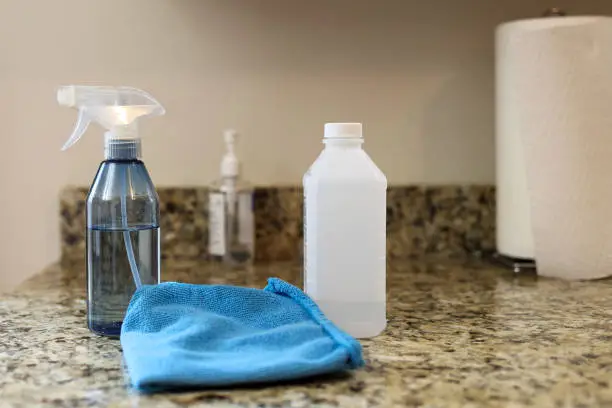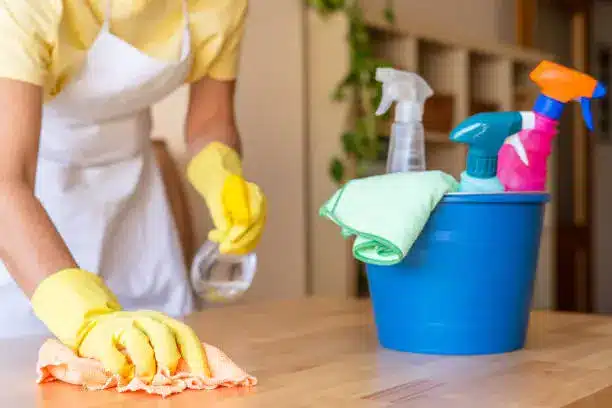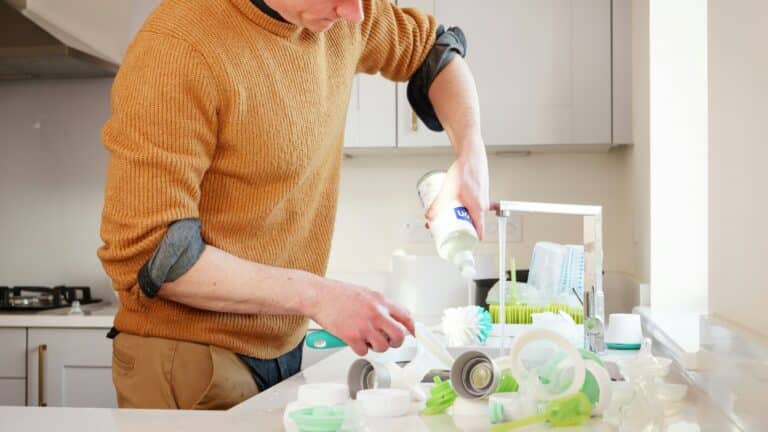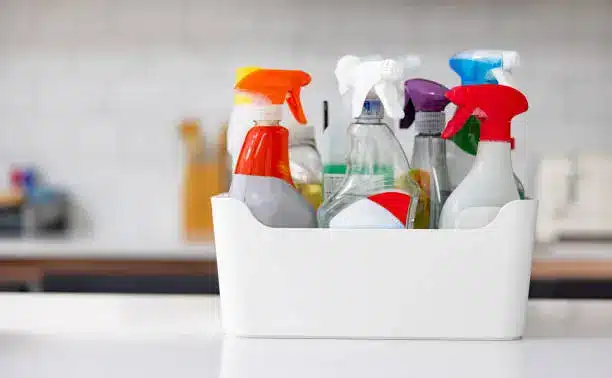It’s no longer just about recycling or driving electric cars; every aspect of our daily lives is being scrutinized for its ecological impact, including how we clean our homes.🍃
Conventional cleaning materials, whether they’re chemicals or disposable wipes, carry a significant environmental toll. Fortunately, there’s a greener, cost-effective alternative available: crafting your own reusable cleaning cloths and pads. This practice allows us to eliminate the environmental footprint of disposable cleaning products, all while maintaining a spotlessly clean living space.💚

With that said, the purpose of this comprehensive guide is to provide you, the reader, with a detailed, step-by-step roadmap to creating your own eco-friendly cleaning tools. We’ll delve into the nitty-gritty of choosing materials, understanding different types of cleaning cloths and pads, as well as walking you through the process of crafting these items.🧵
Why Switch to Reusable Cleaning Tools?
Before diving into the how-to’s, let’s first understand the why’s. We’ll explore the environmental benefits of using reusable cleaning cloths and pads, their economic advantages, and how they stack up against their disposable counterparts in terms of effectiveness. We’ll also delve into the concept of “greenwashing” and how to avoid falling for products that claim to be eco-friendly but aren’t.🔍
Choosing the Right Materials
Once we’ve established the ‘why’, we’ll move on to the ‘what’. Not all materials are created equal when it comes to eco-friendly cleaning. We’ll examine the different types of fabrics that are suitable for reusable cleaning cloths and pads, as well as the pros and cons of each, to help you make an informed decision. 🏷️
Crafting Your Reusable Cleaning Tools
Next, we’ll transition into the ‘how’. This section will provide a thorough, step-by-step tutorial on how to create your reusable cleaning tools. We’ll discuss everything from cutting patterns to sewing techniques, ensuring you have all the information you need to get started.✂️📏
Effective Cleaning Techniques with Reusable Tools
Finally, having the tools is one thing, but knowing how to use them effectively is another. The final section of this guide will cover cleaning techniques that maximize the effectiveness of your reusable cleaning cloths and pads. From tackling tough stains to everyday dusting, we’ll leave you equipped with an array of green cleaning strategies.🧼
By the end of this guide, we aim to have given you the knowledge and skills to create and use reusable cleaning tools confidently. More importantly, we hope to have shown you that choosing eco-friendly cleaning practices doesn’t have to be a compromise on quality or effectiveness, but rather an opportunity to contribute to a more sustainable world. So let’s dive in and get started on this journey towards a cleaner, greener home.🏡
Introduction to Eco-Friendly Cleaning: The Why and How
As the world becomes more aware of the impact of human activities on the environment, many are seeking out ways to minimize their ecological footprint. One such method is through eco-friendly cleaning. Cleaning products are often filled with harsh chemicals that can harm both the environment and our health. However, there’s a sustainable, healthy alternative: crafting your own reusable cleaning cloths and pads! This not only reduces waste but also saves money in the long run.
Homemade cleaning supplies are relatively easy to make and require only a few materials, many of which you may already have in your home. So why not take a step towards a greener planet with eco-friendly cleaning practices? In this guide, I’ll walk you through each step to craft your own reusable cleaning cloths and pads.
Before we dive into the how-to, let’s take a moment to understand why we should opt for eco-friendly cleaning methods. Chemical-based cleaning products can cause water pollution, air pollution, and harm aquatic life when washed down the drain. Not to mention, these chemicals can be harmful to humans too. Thus, switching to homemade, reusable cleaning supplies is beneficial for both the environment and your health.
Materials Needed for Crafting Reusable Cleaning Cloths and Pads
The first step in crafting your own reusable cleaning supplies is gathering the necessary materials. Here’s what you’ll need:
- Old clothes or towels
- Scissors
- Needle and thread or sewing machine
- Baking soda
- White vinegar
- Essential oils (optional)
The beauty of this method is that it primarily uses items you likely already have in your home, reducing waste and making it cost-effective. If you don’t have old clothes or towels, consider purchasing cheap, second-hand ones from a local thrift store. Now, let’s compare this method to the conventional cleaning methods:
| Eco-friendly Cleaning | Conventional Cleaning | |
|---|---|---|
| Cost | Low | High |
| Environmental Impact | Low | High |
| Health Impact | Low | High |
As you can see, eco-friendly cleaning methods are superior in all aspects. But how do we craft these reusable cleaning cloths and pads? Let’s dive into that next.
Step-by-Step Guide to Crafting Reusable Cleaning Cloths and Pads
Now that we have gathered all the necessary materials, let’s get crafting!
Step 1: Cutting the Cloth
Start by cutting your old clothes or towels into squares or rectangles. The size will depend on what you’re comfortable with and the intended use. A larger size might be suitable for a cleaning cloth, while a smaller size would work better for a pad.
Step 2: Sewing the Edges
After you have your cloth pieces cut out, you’ll need to sew the edges to prevent them from fraying. If you’re handy with a needle and thread, you can do this by hand. Otherwise, a sewing machine will do the job much quicker.
Step 3: Making the Cleaning Solution
Next, let’s make the cleaning solution. In a bowl, mix equal parts of baking soda and white vinegar. The solution will fizz, but that’s normal. Once the fizzing stops, you can add a few drops of your favorite essential oil for added scent.
Step 4: Soaking the Cloth
Soak your cloth pieces in the cleaning solution for a few minutes, then wring them out. They’re now ready to be used!
For a visual guide on how to create your own reusable cleaning cloths and pads, check out this YouTube video: “DIY Reusable Cleaning Cloths” by Clean My Space.
Maintaining Your Reusable Cleaning Cloths and Pads
Now that you’ve crafted your own reusable cleaning supplies, it’s important to know how to maintain them. After using your cloth or pad, rinse it out with warm water. If it’s heavily soiled, you can wash it in your washing machine. For disinfection, soak it in a solution of vinegar and water for about 15 minutes, then rinse and let it dry.
By properly maintaining your cleaning supplies, they can last you a long time, saving you even more money and reducing your environmental impact further.
To conclude, crafting your own reusable cleaning cloths and pads is an effective way to reduce waste, save money, and lessen your environmental impact. It’s a simple, cost-effective method that anyone can do. So why not give it a try? Start your journey towards eco-friendly cleaning today!
Conclusion
To sum up, we’ve embarked on a journey through the complex universe of Information Technology (IT) and Engineering, unravelling some of the most intricate concepts. Our exploration has taken us from the foundational principles to the latest advancements, offering a comprehensive overview of these vast fields.
We began by delving into the essential concepts of IT, demystifying terms like software development, network architecture, and data management. We clarified how these fundamental elements of IT play a critical role in the digital age, from boosting business efficiency to enabling groundbreaking innovations. If you wish to read more about these essential IT concepts, I recommend visiting TechRepublic for insightful articles 📚.
In the realm of Engineering, we shed light on the workings of various domains, from civil and mechanical to electrical and aerospace engineering. We emphasized the role of engineering in transforming our world, from constructing colossal skyscrapers to developing cutting-edge technologies. For those who would like to delve deeper into the engineering world, Engineering.com offers an extensive collection of resources and news 🏗️.
Throughout this article, we have strived to explain these intricate concepts in an understandable manner. Our aim has been to make these highly technical areas accessible to all, regardless of their level of expertise. We strongly believe that knowledge should be open to all, and we have made every effort to uphold this principle 💡.
The importance of understanding IT and Engineering cannot be overstated. In today’s fast-paced digital age, these fields are shaping our future. By understanding these concepts, we can better navigate this rapidly evolving landscape, making informed decisions and contributing to the technological advancement of our society.
In conclusion, the journey through IT and Engineering is far from over. There is always more to learn, more to explore. And as we continue to delve into these fascinating realms, we invite you to join us, to comment, to share, and most importantly, to apply the knowledge you have gained.
We encourage you to explore these concepts further, whether through independent study or by enrolling in an academic program. The Association for Computing Machinery and the American Society of Mechanical Engineers offer a wealth of resources and opportunities to expand your understanding 📖.
So, don’t hesitate to immerse yourself in the captivating world of IT and Engineering. Embrace the opportunity to learn, to grow, and to contribute to our collective future. Remember, the journey is as rewarding as the destination 🚀.
Thank you for joining us on this exploration, and we look forward to continuing the journey together.
This article is a result of the author’s thorough research and personal experience in the field of IT and Engineering. All information presented is based on sources believed to be reliable and active at the time of publication.



